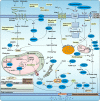Ferroptosis: a double-edged sword mediating immune tolerance of cancer
- PMID: 36335094
- PMCID: PMC9637147
- DOI: 10.1038/s41419-022-05384-6
Ferroptosis: a double-edged sword mediating immune tolerance of cancer
Abstract
The term ferroptosis was put forward in 2012 and has been researched exponentially over the past few years. Ferroptosis is an unconventional pattern of iron-dependent programmed cell death, which belongs to a type of necrosis and is distinguished from apoptosis and autophagy. Actuated by iron-dependent phospholipid peroxidation, ferroptosis is modulated by various cellular metabolic and signaling pathways, including amino acid, lipid, iron, and mitochondrial metabolism. Notably, ferroptosis is associated with numerous diseases and plays a double-edged sword role. Particularly, metastasis-prone or highly-mutated tumor cells are sensitive to ferroptosis. Hence, inducing or prohibiting ferroptosis in tumor cells has vastly promising potential in treating drug-resistant cancers. Immunotolerant cancer cells are not sensitive to the traditional cell death pathway such as apoptosis and necroptosis, while ferroptosis plays a crucial role in mediating tumor and immune cells to antagonize immune tolerance, which has broad prospects in the clinical setting. Herein, we summarized the mechanisms and delineated the regulatory network of ferroptosis, emphasized its dual role in mediating immune tolerance, proposed its significant clinical benefits in the tumor immune microenvironment, and ultimately presented some provocative doubts. This review aims to provide practical guidelines and research directions for the clinical practice of ferroptosis in treating immune-resistant tumors.
© 2022. The Author(s).
Conflict of interest statement
The authors declare no competing interests.
Figures


Similar articles
-
The diversified role of mitochondria in ferroptosis in cancer.Cell Death Dis. 2023 Aug 14;14(8):519. doi: 10.1038/s41419-023-06045-y. Cell Death Dis. 2023. PMID: 37580393 Free PMC article. Review.
-
Ferroptosis and tumor immunity: In perspective of the major cell components in the tumor microenvironment.Eur J Pharmacol. 2023 Dec 15;961:176124. doi: 10.1016/j.ejphar.2023.176124. Epub 2023 Nov 3. Eur J Pharmacol. 2023. PMID: 37925133 Review.
-
The new era of lung cancer therapy: Combining immunotherapy with ferroptosis.Crit Rev Oncol Hematol. 2024 Jun;198:104359. doi: 10.1016/j.critrevonc.2024.104359. Epub 2024 Apr 12. Crit Rev Oncol Hematol. 2024. PMID: 38615871 Review.
-
A double-edged sword with a therapeutic target: iron and ferroptosis in immune regulation.Nutr Rev. 2023 Apr 11;81(5):587-596. doi: 10.1093/nutrit/nuac071. Nutr Rev. 2023. PMID: 36130411 Review.
-
p53: A double-edged sword in tumor ferroptosis.Pharmacol Res. 2022 Mar;177:106013. doi: 10.1016/j.phrs.2021.106013. Epub 2021 Nov 29. Pharmacol Res. 2022. PMID: 34856333 Review.
Cited by
-
Deeper insight into ferroptosis: association with Alzheimer's, Parkinson's disease, and brain tumors and their possible treatment by nanomaterials induced ferroptosis.Redox Rep. 2023 Dec;28(1):2269331. doi: 10.1080/13510002.2023.2269331. Epub 2023 Nov 27. Redox Rep. 2023. PMID: 38010378 Free PMC article. Review.
-
Unveiling the mechanism of photothermal therapy in acne man-agement: targeting sebaceous gland ferroptosis via umbilical cord mesenchymal stem cell membrane-encapsulated Au-Ag-PDA.Front Bioeng Biotechnol. 2024 Jun 10;12:1426477. doi: 10.3389/fbioe.2024.1426477. eCollection 2024. Front Bioeng Biotechnol. 2024. PMID: 38915336 Free PMC article.
-
Overexpression of ELF3 in the PTEN-deficient lung epithelium promotes lung cancer development by inhibiting ferroptosis.Cell Death Dis. 2024 Dec 18;15(12):897. doi: 10.1038/s41419-024-07274-5. Cell Death Dis. 2024. PMID: 39695109 Free PMC article.
-
Ferroptosis crosstalk in anti-tumor immunotherapy: molecular mechanisms, tumor microenvironment, application prospects.Apoptosis. 2024 Dec;29(11-12):1914-1943. doi: 10.1007/s10495-024-01997-8. Epub 2024 Jul 15. Apoptosis. 2024. PMID: 39008197 Review.
-
Targeting regulated cell death pathways in cancers for effective treatment: a comprehensive review.Front Cell Dev Biol. 2024 Nov 15;12:1462339. doi: 10.3389/fcell.2024.1462339. eCollection 2024. Front Cell Dev Biol. 2024. PMID: 39620145 Free PMC article. Review.
References
Publication types
MeSH terms
Substances
LinkOut - more resources
Full Text Sources
Medical
Miscellaneous

